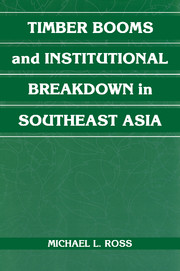Book contents
- Frontmatter
- Contents
- Illustrations
- Tables
- Preface
- 1 Introduction: Three Puzzles
- 2 The Problem of Resource Booms
- 3 Explaining Institutional Breakdown
- 4 The Philippines: The Legal Slaughter of the Forests
- 5 Sabah, Malaysia: A New State of Affairs
- 6 Sarawak, Malaysia: An Almost Uncontrollable Instinct
- 7 Indonesia: Putting the Forests to “Better Use”
- 8 Conclusion: Rent Seeking and Rent Seizing
- Appendix: Chronologies of Events
- References
- Index
7 - Indonesia: Putting the Forests to “Better Use”
Published online by Cambridge University Press: 30 July 2009
- Frontmatter
- Contents
- Illustrations
- Tables
- Preface
- 1 Introduction: Three Puzzles
- 2 The Problem of Resource Booms
- 3 Explaining Institutional Breakdown
- 4 The Philippines: The Legal Slaughter of the Forests
- 5 Sabah, Malaysia: A New State of Affairs
- 6 Sarawak, Malaysia: An Almost Uncontrollable Instinct
- 7 Indonesia: Putting the Forests to “Better Use”
- 8 Conclusion: Rent Seeking and Rent Seizing
- Appendix: Chronologies of Events
- References
- Index
Summary
Indonesia's abundant forest resources are still untapped. It is high time that (the forests) be put into better use…. Gentlemen, old cracks in the business will need no further detail on this subject matter.
Sudjarwo, Indonesian Director General of Forestry, 1968 (Philippine Lumberman 1968a)In the late 1960s, Philippine log exports began to decline; at the same time, Indonesia's timber exports began to soar. By 1973 Indonesia had replaced the Philippines as the world's leading hardwood exporter. Timber also became Indonesia's largest source of foreign exchange, after oil.
The case of Indonesia differs from the others in three important ways. First, its forestry institutions were far weaker. In the Philippines, Sabah, and Sarawak, rent seizing damaged the institutions that fostered sustained-yield forestry. The Indonesian government had no such institutions in the 1960s and early 1970s; there was little to dismantle. But the Indonesian forests had been protected, in part, by nonstate institutions – the institutions of adat, or customary law. Of the four cases in this study, Indonesia and Sabah had made the greatest strides – before their timber booms – toward recognizing the customary land rights of forest dwellers. Shortly after the timber boom began, the Indonesian government rescinded those rights, to boost the size of the windfall.
Second, Indonesia's boom was not triggered by rising international timber prices; rather, it was caused by the government's efforts in 1966 and 1967 to lower the costs of cutting and exporting timber.
- Type
- Chapter
- Information
- Timber Booms and Institutional Breakdown in Southeast Asia , pp. 157 - 189Publisher: Cambridge University PressPrint publication year: 2001



